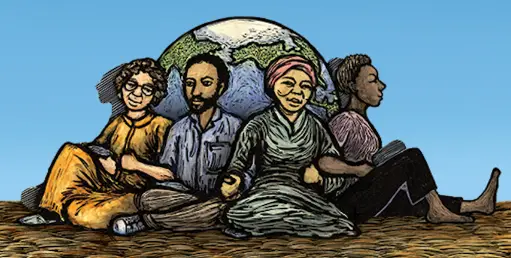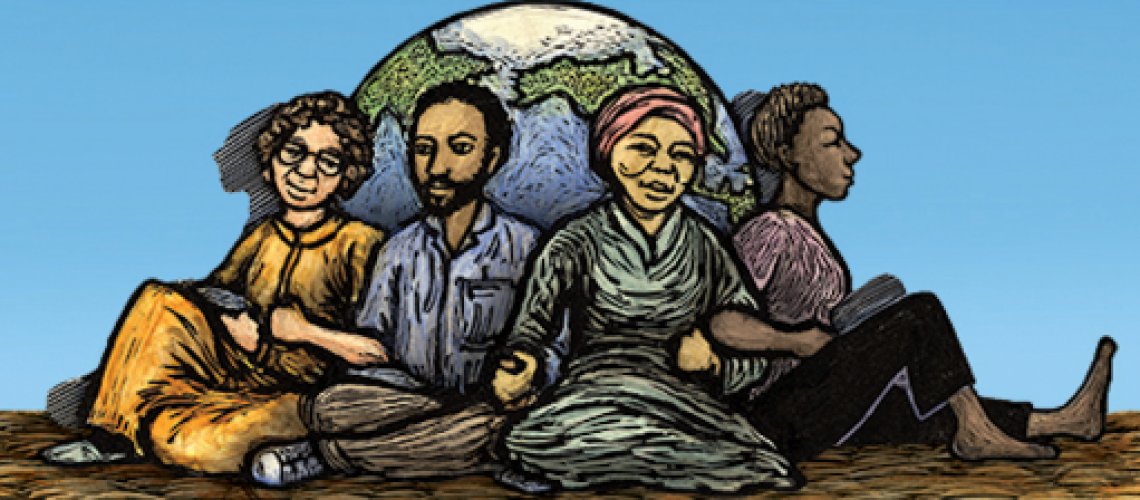Environmental justice artwork has been gaining attention in recent years as people become more aware of climate change and other environmental issues. It can take many forms, from traditional paintings and sculptures to digital media and performance art.
The aim of this article is to explore the many ways that artists are using their work to bring attention to environmental justice artwork issues. This article will examine the range of topics that these works address, such as pollution, deforestation, biodiversity loss, and habitat destruction.

It will also look at how artists are using their artwork to make a positive impact on the environment. Through interviews with leading environmental justice artists, we will gain insight into how they use their art as a form of activism and what drives them to create meaningful works about our planet’s future.
Types Of Environmental Justice Artwork
Environmental justice artwork is an important way for people to express their concerns about climate change and environmental destruction. According to the Smithsonian Institute, over 75% of all artworks related to environmental issues created since the 1950s have been focused on environmental justice.
This includes a range of mediums from traditional paintings and drawings to digital works, video installations, public performances, and social media campaigns.
The majority of environmental justice artwork focuses on topics such as pollution and deforestation. It often portrays the destructive effects these activities can have on the environment, particularly when it comes to marginalized communities that are disproportionately impacted by them.
Artwork may also act as a call to action by encouraging viewers to take part in movements for environmental protection or inspiring them with messages of hope for a greener future.
Environmental justice artwork serves many purposes but ultimately seeks to make people aware of the dire consequences that can result from human activities that harm the environment. Through its visual representation of these issues, it has become an effective tool for raising awareness and creating dialogue around urgent ecological issues.
Pollution And Deforestation
Environmental justice artwork has sought to bring attention to the environmental issues of pollution and deforestation. These problems can be seen in smog-filled skies, acres of land cleared for development, and resources being stripped from the earth.
- Pollution is a major issue, with air quality decreasing and hazardous chemicals entering our water sources.
- Deforestation is equally concerning, as trees play a crucial role in maintaining our planet’s health through providing oxygen, shelter for animals, and reducing soil erosion.
- Additionally, the loss of natural habitats due to deforestation affects many species that could become endangered or extinct if these activities continue unchecked.
We must take action now to prevent further damage from occurring as a result of pollution and deforestation. The next step in this journey is to address biodiversity loss and habitat destruction so that we can protect the earth and its inhabitants for generations to come.
Biodiversity Loss And Habitat Destruction
The environmental justice movement has been pushing for change for decades. It speaks to the idea that everyone should have access to clean air, water, and soil no matter their race, class, or gender. One of the most pressing issues in environmental justice is biodiversity loss and habitat destruction.
Biodiversity loss refers to a decrease in the variety of species within an environment. This can be caused by factors such as climate change, pollution, or human activity like overhunting or deforestation. When habitats are destroyed, they can no longer provide resources for its inhabitants which can lead to displacement and even extinction of certain species. The table below outlines some of the effects of biodiversity loss and habitat destruction:
| Effects | Biodiversity Loss | Habitat Destruction |
|---|---|---|
| Increase in invasive species | Degradation of ecological services | Fragmentation of animal populations |
| Decrease in genetic diversity | Reduction of available resources | Loss of unique ecosystems & habitats |
These effects are not only damaging to native wildlife but also disrupts food webs which harms our ecosystem’s balance and ultimately affects us all. In order to protect our planet’s biodiversity we must take action by reducing our carbon footprint through sustainable practices and protecting natural habitats from further destruction.
Artwork has been used as a way to draw attention to these important issues by inspiring people to take action through engaging visuals. Art has the power to spark conversations about social and political issues while connecting people with nature on an emotional level so that they are more invested in protecting its future.
Art As Activism
The biodiversity loss and habitat destruction caused by human activity is a major environmental justice issue. It has led to severe consequences, including the extinction of species, increased food insecurity, and extreme weather events. Unfortunately, many governments are not taking the necessary steps to protect our planet’s biodiversity and habitats.
However, there is hope in the form of art as activism. Artists can use their work to raise awareness about important issues like environmental justice. Through their craft, they can create powerful visuals that inspire people to take action and make a difference in the world. Additionally, artwork can be used to bring attention to neglected topics or stories that may otherwise go unheard.
Artists have long been at the forefront of environmental justice movements, pushing for change and inspiring others to do the same. In order to get a better understanding of this work, it is important to hear directly from these artists themselves – which will be discussed in the next section on interviews with environmental justice artists.
As we enter into this discussion on how art can be used as an effective tool for activism, it is crucial that we gain insight from those who have been doing this work for years.
Interviews With Environmental Justice Artists
It is clear that environmental justice artwork has a profound impact on society. To get a better understanding of this, it is important to look to the source – the artists themselves. Interviews with environmental justice artists can provide a unique insight into their work and the motivations behind it.
Here are four key takeaways from these interviews:
- Environmental justice artwork is often created out of a love for nature and a passion for protecting our planet.
- It is also driven by a need to bring attention to injustices that might otherwise be ignored or minimized.
- Artists often draw inspiration from personal experiences, as well as news stories and other sources of information about environmental issues.
- The artwork can be used to educate, challenge perceptions, and inspire action on environmental issues.
These interviews offer an intimate look at how environmental justice artwork is created and its potential impact on society. From here, we can move on to explore the actual impact of this art form – both in terms of raising awareness and inspiring positive change in our communities.
The Impact Of Environmental Justice Artwork
The impact of environmental justice artwork is not easily forgotten. From street murals to canvas works, the power of this artform captures attention and stirs emotion.
Colors that pop from the wall like a rainbow, an array of shapes and images that draw you in – it’s hard to turn away.
Environmental justice artwork is more than just decoration. It serves as a reminder that our planet needs protection. Through its use of symbolism and strong messages, it can inspire people to take action towards creating a better future for all.
This type of art speaks volumes on behalf of those facing injustices related to environmental issues, calling out wrongdoings while still offering hope for change.
We must acknowledge the beauty that environmental justice artwork brings into our world as well as its lasting impact on how we view our environment and each other. Only then can we begin to make progress towards a more equitable and sustainable future for generations to come.
Frequently Asked Questions
What Are The Legal Implications Of Environmental Justice Artwork?
Legal implications of artwork can be complex, especially when it pertains to environmental justice. Depending on the content and how it’s used, the artist could face both civil and criminal charges.
For example, if the artwork is used in a way that disrupts public order or violates another person’s rights, then legal action may be taken against the creator.
In addition, if the artwork contains copyrighted material or trademarks without permission from the owner, there could be serious repercussions for the artist as well.
How Can Environmental Justice Artwork Be Used To Influence Policy Decisions?
Artwork can be used to influence policy decisions in many ways.
It can draw attention to issues by providing a visual representation of the problem, and it can also be used to create public awareness and generate support for change.
By creating art that is visually powerful and emotionally resonant, activists can use it to pressure decision-makers into making changes that are more equitable and just.
Art can also be used to educate people about the importance of environmental justice, as well as inspire them to take action in their own communities.
What Are The Most Effective Strategies For Creating Environmental Justice Artwork?
Creating artwork to influence policy decisions related to environmental justice is an effective way of making a statement and raising awareness.
It can be used to spark conversations, draw attention to pressing issues, and encourage people to take action.
However, there are various strategies that artists can use when creating this type of artwork, such as combining art with activism or utilizing technology-based platforms.
It’s important for artists to understand the impact their art can have and consider the most effective ways to communicate their message.
How Has The Global Pandemic Impacted Environmental Justice Artwork?
The global pandemic has undoubtedly had an immense impact on the art world. Many galleries and museums have been closed, leaving artists struggling to find a platform for their work.
Environmental justice artwork is no exception; it has become increasingly difficult for artists to showcase their work in meaningful ways, forcing them to explore alternative methods of expression.
Allusion can be used to evoke an emotional response from the audience, allowing these works to reach a larger audience and help create awareness about environmental issues that are too often neglected.
What Are The Most Effective Ways Of Disseminating Environmental Justice Artwork?
The dissemination of artwork is an important part of its success and impact. It’s essential to consider the most effective ways of getting artwork out there in order to truly make a difference.
From exhibitions and shows, to online platforms, there are many possibilities for creators when it comes to sharing their work on environmental justice issues.
It’s important to think about the best way to reach one’s audience in order to make the biggest possible impact with one’s art.
Conclusion
Environmental justice artwork is a powerful tool for influencing policy decisions and raising awareness about social and environmental issues. It can be used to draw attention to the needs of underserved communities, inspire people to take action and hold governments accountable for their policies. Environmental justice cases is another hot topic in America to talk about.
But how can we ensure that environmental justice artwork reaches its intended audience? How can we make sure that it has an impact on creating a more equitable society? These are questions that must be addressed as we move forward in our ongoing fight for environmental justice.

